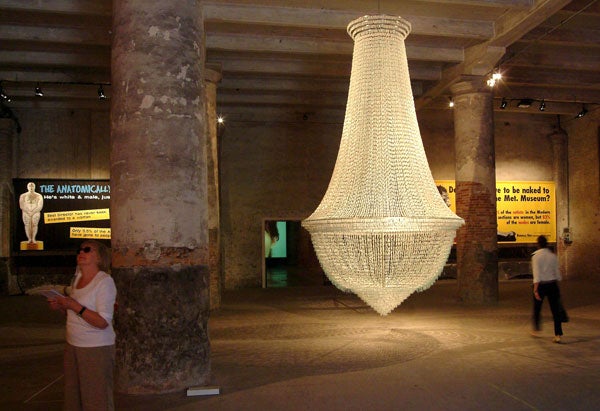The Diary: Anton Edelmann; Kenwood House; Joana Vasconcelos; Neil Gaiman; Alexei Sayle

Your support helps us to tell the story
From reproductive rights to climate change to Big Tech, The Independent is on the ground when the story is developing. Whether it's investigating the financials of Elon Musk's pro-Trump PAC or producing our latest documentary, 'The A Word', which shines a light on the American women fighting for reproductive rights, we know how important it is to parse out the facts from the messaging.
At such a critical moment in US history, we need reporters on the ground. Your donation allows us to keep sending journalists to speak to both sides of the story.
The Independent is trusted by Americans across the entire political spectrum. And unlike many other quality news outlets, we choose not to lock Americans out of our reporting and analysis with paywalls. We believe quality journalism should be available to everyone, paid for by those who can afford it.
Your support makes all the difference.A delicate matter
Anton Edelmann, the former Savoy chef whose protégés include the young Giorgio Locatelli, was at Sotheby's in London this week, serving guests and fellow gourmands including Locatelli, Brian Mosimann, Mark Hix and John Williams, a 16th-century recipe for cooking dor-mice. Edelmann tells me he selected a menu based around ancient recipes including one for that Roman delicacy, the humble dormouse. While he did not stay completely true to the original – he used rabbit – he thinks 16th- century recipes can be adapted for contemporary palates. "Dormouse was a delicacy, it wasn't because they could find nothing else to eat. The only reason I stuck it on the menu is because it tickled me. The guests liked it, it tickled them, too." His feast was made to celebrate the sale, Books for Cooks, of a private collection of culinary literature from the 16th century to the present day, compiled by Stanley J Seeger. As well as Apicius Coelieus's mock dormouse dish on Edelmann's menu were canapés from Athenaeus, peaches à la Verenne, and chocolates from a 1644 text.
Always a woman
The most surprising thing for anyone who turned out to see Ray Davies at Kenwood House last year was that it didn't rain constantly this time round, for Blondie's sell out concert at the open-air north London venue. An even greater surprise lies in wait for those who have booked to see Rufus Wainwright there tomorrow. Although it is not yet announced, a reliable source tells me that he has asked Fyfe Dangerfield from the Mercury prize-nominated indie rock band, Guillimots, to perform with him in a "surprise" appearance. For anyone racking their brains to remind themselves of who Dangerfield is, think of the voice behind the insanely popular cover of Billy Joel's She's Always A Woman, in the John Lewis television advert, that became a YouTube phenomenon earlier this year.
Shedding light on a female foible
Fans of the artist Joana Vasconcelos are hoping she will bring her famous "tampon chandelier" to London when she stages her solo show at the Haunch of Venison, in London, on 21 July. Vasconcelos, who makes large-scale sculptures, is considered by some to be the Louise Bourgeois of Portugal – she lives in Lisbon – and her pièce de résistance of recent shows, including one in Portugal that became the most highly attended exhibition for years – is a piece called A Noiva (The Bride), which, from a distance looks like a large, pendulous chandelier. Only up close does the viewer observe that it is made of thousands of tampons, strung together by a cotton thread and hung from steel cables. Another cracker is a big, circular crocheted work called "Big Booby". The show is called I Will Survive, inspired by Gloria Gaynor's disco classic.
Ghost of a chance
Neil Gaiman tells me he is writing a script for a First World War feature film that David Lean once optioned in the 1950s. It is an adaptation of Elias Henry Jones's book, The Road to Endor, written in 1920, that tells the true story of two prisoners who trick their guards into believing they are in touch with the spirit world in order to escape from a Turkish prison camp. The story is an extraordinary one, says Gaiman. "I fell in love with the book. What happened was bizarre and magical. Their escape plan involved telepathy, mentalism and convincing the Turkish commandant that they were able to talk to ghosts. They got out, but they had an awful fallback plan to fake madness and so they wound up in a mental institution in Constantinople."
Sayle's well-versed
A football match kicked off the London Literature Festival near Jubilee Gardens, along London's Southbank this week, for which the comedian Alexei Sayle turned up to referee on his bike, arguably a more reliable method than one employed by his professional counterparts in South Africa. The one-off match pitting writers against scientists had, observers tell me, far more poetry than England's lacklustre performance this week.
Join our commenting forum
Join thought-provoking conversations, follow other Independent readers and see their replies
Comments